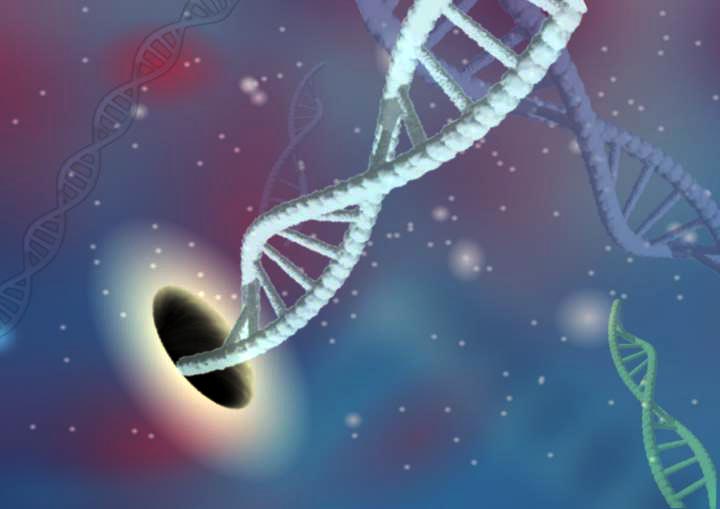Through the nano hole

Artist's impression of DNA polymer transport through a nanopore
Credit: Kaikai Chen
LEGO technique reveals the physics of DNA transport through nanopores.
A new technique established by a team of researchers from the University of Cambridge and the University of Massachusetts reveals the fundamental physics of how a polymer such as DNA threads through holes 10,000 times smaller than the width of a human hair.
Polymers are long, chain-like molecules which are everywhere in biology. DNA and RNA are polymers formed by many consecutive copies of nucleotides coupled together. When being transported within or between cells, these biological polymers must pass through nanometre-sized holes called “nanopores”.
This process also underlies a rapidly developing method for analysing and sequencing DNA called nanopore sensing.
The study, published in the journal Nature Physics, shows how the Cavendish-led team developed a new LEGO-like technique for assembling DNA molecules that have protruding bumps at specific locations along their length. By passing these DNA molecules through a nanopore and analysing simultaneous changes in the pattern of ion flow, the researchers determined with great precision how the speed of the DNA changes as it moves through.
The experimental results revealed a two-step process where the DNA speed initially slows down before accelerating close to the end of the translocation. Simulations also demonstrated this two-stage process and helped to reveal that the underlying physics of the process is determined by changing friction between the DNA and surrounding fluid.
“Our method for assembling LEGO-like molecular DNA rulers has given new insight into the process of threading polymers through incredibly small holes just a few nanometres in size,” explained Senior author Dr Nicholas Bell from Cambridge’s Cavendish Laboratory. “The combination of both experiments and simulations have revealed a comprehensive picture of the underlying physics of this process and will aid the development of nanopore-based biosensors. It is very exciting that we can now measure and understand these molecular processes in such minute detail.”
“These results will help improve the accuracy of nanopore sensors in their various applications, for instance localising specific sequences on DNA with nanometer accuracy or detecting diseases early with target RNA detection,” said lead author Kaikai Chen.
“The superior resolution in analysing molecules passing through nanopores will allow for low-error decoding of digital information stored on DNA. We are exploring and improving the utility of nanopore sensors for these applications.”
###
Reference: Chen, K., Jou, I., Ermann, N. et al. ‘Dynamics of driven polymer transport through a nanopore.’ Nature Physics (2021). DOI: 10.1038/s41567-021-01268-2
All latest news from the category: Life Sciences and Chemistry
Articles and reports from the Life Sciences and chemistry area deal with applied and basic research into modern biology, chemistry and human medicine.
Valuable information can be found on a range of life sciences fields including bacteriology, biochemistry, bionics, bioinformatics, biophysics, biotechnology, genetics, geobotany, human biology, marine biology, microbiology, molecular biology, cellular biology, zoology, bioinorganic chemistry, microchemistry and environmental chemistry.
Newest articles

Webb captures top of iconic horsehead nebula in unprecedented detail
NASA’s James Webb Space Telescope has captured the sharpest infrared images to date of a zoomed-in portion of one of the most distinctive objects in our skies, the Horsehead Nebula….

Cost-effective, high-capacity, and cyclable lithium-ion battery cathodes
Charge-recharge cycling of lithium-superrich iron oxide, a cost-effective and high-capacity cathode for new-generation lithium-ion batteries, can be greatly improved by doping with readily available mineral elements. The energy capacity and…

Novel genetic plant regeneration approach
…without the application of phytohormones. Researchers develop a novel plant regeneration approach by modulating the expression of genes that control plant cell differentiation. For ages now, plants have been the…





















